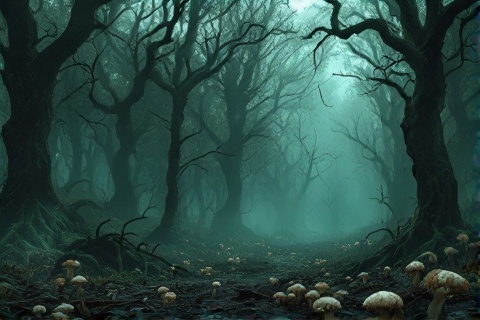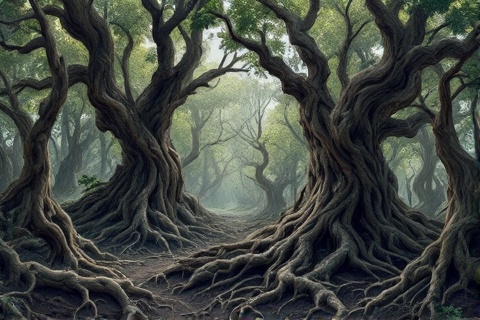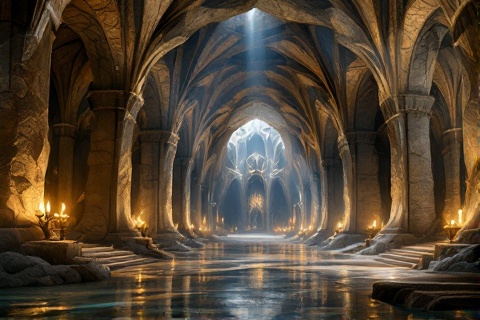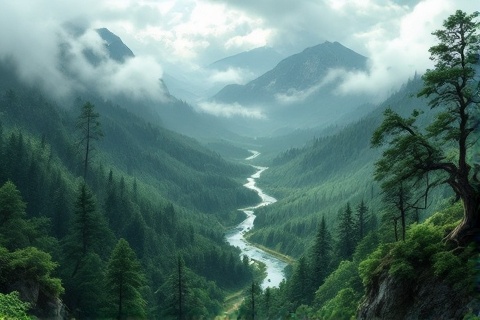
Mirkwood: The Dark Heart of Middle-earth's Wilderland
Unveiling the Enchantment, Perils, and Secrets of Tolkien's Legendary Forest
The Ancient Forest of Greenwood the Great

In the Elder Days of Middle-earth, a vast forest known as
Greenwood the Great stretched magnificently across the eastern lands, extending
over 400 miles from its northernmost reaches to its southern borders. This
immense woodland realm stood as one of the most ancient forests of Arda,
predating even the awakening of the Elves.
Among the greatest forests of Middle-earth, Greenwood dominated the expansive
region east of the Misty Mountains, creating a formidable natural barrier
between the Vales of Anduin and the lands that would later become known as
Rhovanion. Its sheer size and density made it a crucial geographical feature of
Middle-earth, influencing travel routes and the settlement patterns of various
peoples throughout the ages.
The northern reaches of the forest became home to the Silvan Elves, who
established their realm under the leadership of Oropher and later his son
Thranduil. These Wood-elves, though less mighty than
their Noldorin kin, maintained a strong presence in the forest's northern
regions, developing a unique culture deeply connected to the woodland realm they
inhabited.
The Shadow of Darkness Descends
The transformation of Greenwood the Great into Mirkwood began around T.A. 1050
when Sauron, disguised as the Necromancer, established his
fortress at Dol Guldur in the forest's southern reaches. His malevolent presence
gradually corrupted the once-beautiful woodland, turning it into a place of
darkness and fear that earned its new name: Mirkwood, or
Taur-nu-Fuin in the elvish tongue.
The forest's canopy grew so thick and black that it nearly completely blocked
out the sun, creating an perpetual twilight beneath the trees. Even during the
brightest days, only occasional shafts of sunlight managed to pierce through the
dense foliage, casting eerie beams through the gloom.
The very air within Mirkwood became thick and oppressive, heavy with the scents
of decay and stagnation. Throughout the forest, dark pools gathered, their
waters black and still, releasing noxious vapors that added to the overwhelming
atmosphere of corruption that pervaded the woodland realm.
A Maze of Roots and Branches

The trees of Mirkwood grew exceptionally close together, their massive trunks
covered in rough, dark bark that seemed to absorb what little light filtered
through the canopy. These ancient sentinels stood like silent guardians, their
surfaces worn and weathered by countless centuries of exposure to the forest's
corrupting influence.
The forest floor proved treacherous to travelers, with gnarled and twisted roots
creating a complex maze of obstacles. These massive root systems intertwined and
overlapped, forming natural traps that could easily snare an unwary foot or
twist an ankle of even the most careful walker.
High above the forest floor, the branches of neighboring trees grew together in
complex patterns, forming an almost solid ceiling that blocked out the sky. This
natural roof stretched for leagues in every direction, creating an endless
twilight realm beneath its spreading boughs.
Some of the oldest trees in Mirkwood reached truly monumental proportions, with
trunks as wide as houses and roots that delved deep into the earth. These
ancient giants dated back to the Elder Days, their massive forms serving as
silent witnesses to the passing of ages in Middle-earth.
The Forest's Dangerous Flora
Among Mirkwood's unique inhabitants were its black squirrels, creatures found
nowhere else in Middle-earth. These quick and agile animals darted through the
branches above, their dark fur helping them blend perfectly with the shadows of
their woodland home.
Perhaps the most unsettling feature of Mirkwood were the thick cobwebs that
stretched between many trees, particularly in the southern regions near Dol
Guldur. These were no ordinary spider webs, but the work of the spawn of
Ungoliant, massive spiders that had taken up residence
in the darkest corners of the forest.
Throughout the forest floor, clusters of fungi and mushrooms grew in abundance,
thriving in the perpetual darkness and damp conditions. These growths often
emitted foul odors and some possessed dangerous properties, their pale and
sickly appearance serving as a warning to travelers to avoid them.
The Elvish Road and Forest River

Through the heart of Mirkwood ran an ancient stone-paved path, a remnant of
older and brighter days when the forest was still called Greenwood the Great.
This road, though often overgrown and difficult to follow, provided one of the
few reliable routes through the perilous forest for those brave or desperate
enough to attempt the crossing.
One of the most dangerous features within Mirkwood was the enchanted black
stream, known for its sleep-inducing powers. Any creature unfortunate enough to
touch or drink its waters would fall into a deep slumber, making the stream a
particularly hazardous obstacle for travelers attempting to cross the forest.
The Forest River served as a vital lifeline through northern Mirkwood, providing
both a navigation route and a source of clean water. This powerful waterway cut
through the forest's northern reaches, eventually joining the Running River near
the Long Lake.
The Wood-elves of Thranduil's realm constructed an elaborate network of wooden
bridges and platforms throughout their territory in northern Mirkwood. These
structures, built high among the trees, allowed the Elves to move swiftly and
secretly through their domain while avoiding the dangers that lurked on the
forest floor.
The Elven-king's Halls

The heart of the Woodland Realm lay within a vast network of caves, serving as
the palace of King Thranduil and his people. These caverns, carefully excavated
and enhanced over many centuries, provided a secure fortress that combined
natural defense with elvish artistry.
Throughout the cave system, grand halls extended deep into the hillside, their
walls adorned with pillars that had been skillfully carved from the living rock.
These columns maintained the structural integrity of the caves while showcasing
the architectural expertise of the Wood-elves.
The underground chambers of the Woodland Realm were illuminated by countless red
torches, their warm light reflecting off the smooth stone walls and creating an
atmosphere both regal and mysterious. The strategic placement of these lights
transformed what might have been dark and forbidding caves into comfortable
living spaces worthy of an elven king.
The Borders and Boundaries

The eastern boundary of Mirkwood was clearly defined by the Running River, which
flowed swiftly along the forest's edge before merging with the Forest River and
continuing toward Esgaroth and the Long Lake. This natural
border helped protect the eastern reaches of the forest from incursions and
provided a vital water source for the surrounding regions.
To the west, Mirkwood's borders gradually transitioned into the foothills of the
Misty Mountains, creating a varied landscape of increasing elevation. This
western edge of the forest was marked by thinning trees and rocky outcrops that
signaled the beginning of the mountain range's territory.
The northern reaches of Mirkwood eventually gave way to the harsh landscape of
the Grey Mountains, where the forest gradually thinned and the trees became more
stunted due to the colder climate and higher elevation. This transition zone
marked the limit of the forest's growth in the north.
In the south, Mirkwood's borders extended toward the Brown Lands, a desolate
region that lay between the forest and the land of Mordor. This
southern portion of the forest was particularly dark and dangerous, influenced
by the evil presence of Dol Guldur and largely avoided by all but the most
desperate or foolhardy travelers.
